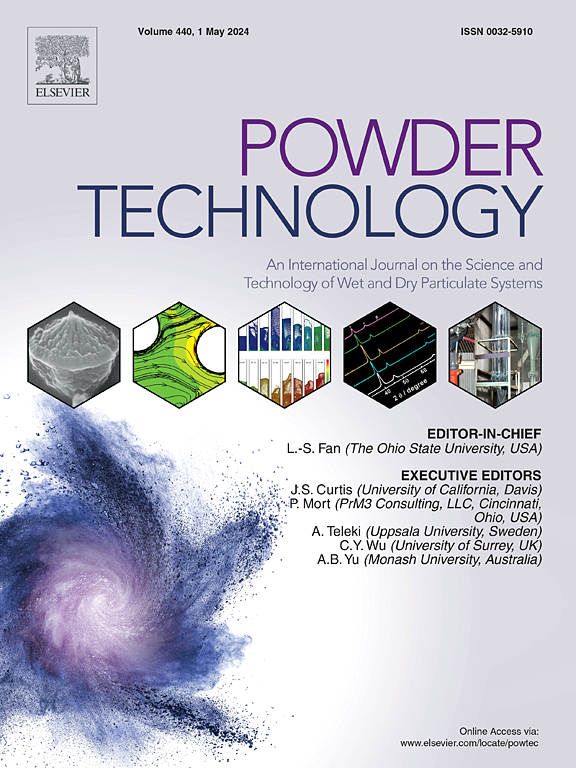高压均质湿磨法制备的人参超细粉的植物化学特性和抗氧化活性
IF 4.5
2区 工程技术
Q2 ENGINEERING, CHEMICAL
引用次数: 0
摘要
人参广泛应用于农产品、膳食保健品和药物制剂,具有巨大的市场潜力。开发更高效、更环保的人参粉生产工艺意义重大。然而,由于人参纤维含量较高,干磨法很难将人参碾磨到理想状态。同时,人参在液体中悬浮时具有高粘度,这给湿法研磨工艺带来了挑战。为了开发理化性能优异的人参粉生产工艺,本研究采用干法研磨(球磨机)和湿法研磨(胶体磨&高压均质机)两种方法获得了三种人参粉。研究还考察了不同人参粉末的粉末特性、结构特性、皂苷含量和抗氧化活性。结果表明,采用高压均质工艺的湿法研磨技术能显著改善人参粉末的性能,包括粒度、比表面积、跨度值、持水量和外观。此外,粉末中的皂苷含量和抗氧化活性也得到了显著提高。研究结果表明,高压均质工艺是生产富含生物活性化合物的植物粉末的一种有前途的技术,可增强其生物活性。该方法被认为是生产人参超细粉的重要替代技术。此外,该研究还为应用高压均质工艺从高纤维植物中制备粒径更小的超细粉提供了理论和技术支持。本文章由计算机程序翻译,如有差异,请以英文原文为准。

Phytochemical properties and antioxidative activities of ginseng superfine powders prepared by wet grinding method with high-pressure homogenization
Ginseng is widely used in agricultural products, dietary health supplements, and pharmaceutical preparations, which has significant market potential. It is of great significance to develop a more efficient and environmentally friendly production process of ginseng powder. However, ginseng is difficult to be milled to an ideal state by dry grinding method because of its higher fiber content. In the meantime, ginseng has high viscosity when suspended in a liquid, which can pose challenges during wet grinding processes. In order to develop a production process for ginseng powder with excellent physicochemical properties, three kinds of powders were obtained by both dry grinding method (ball mill) and wet grinding method (colloid mill&high-pressure homogenizer) in this study. The powder properties, structural properties, saponin contents,and antioxidant activity of different ginseng powders were also investigated. The results showed that wet grinding technology using a high-pressure homogenization process could significantly improve the powder properties,including the particle size, specific surface area, span value, water holding capacity, and appearance. Moreover, both the saponin contents and the antioxidant activity of the powder had been significantly enhanced. The findings indicated that high-pressure homogenization process was a promising technique for producing plant powders rich in bioactive compounds, which could enhance their bioactivity. The method was argued to be a significant alternative technology for production of ginseng ultrafine powders. Furthermore, it offered theoretical and technical support for the application of the high-pressure homogenization process in the preparation of ultrafine powders with reduced particle sizes from high-fiber plants.
求助全文
通过发布文献求助,成功后即可免费获取论文全文。
去求助
来源期刊

Powder Technology
工程技术-工程:化工
CiteScore
9.90
自引率
15.40%
发文量
1047
审稿时长
46 days
期刊介绍:
Powder Technology is an International Journal on the Science and Technology of Wet and Dry Particulate Systems. Powder Technology publishes papers on all aspects of the formation of particles and their characterisation and on the study of systems containing particulate solids. No limitation is imposed on the size of the particles, which may range from nanometre scale, as in pigments or aerosols, to that of mined or quarried materials. The following list of topics is not intended to be comprehensive, but rather to indicate typical subjects which fall within the scope of the journal's interests:
Formation and synthesis of particles by precipitation and other methods.
Modification of particles by agglomeration, coating, comminution and attrition.
Characterisation of the size, shape, surface area, pore structure and strength of particles and agglomerates (including the origins and effects of inter particle forces).
Packing, failure, flow and permeability of assemblies of particles.
Particle-particle interactions and suspension rheology.
Handling and processing operations such as slurry flow, fluidization, pneumatic conveying.
Interactions between particles and their environment, including delivery of particulate products to the body.
Applications of particle technology in production of pharmaceuticals, chemicals, foods, pigments, structural, and functional materials and in environmental and energy related matters.
For materials-oriented contributions we are looking for articles revealing the effect of particle/powder characteristics (size, morphology and composition, in that order) on material performance or functionality and, ideally, comparison to any industrial standard.
 求助内容:
求助内容: 应助结果提醒方式:
应助结果提醒方式:


